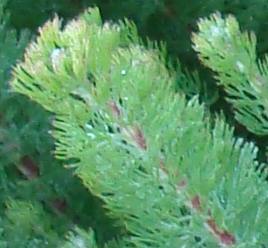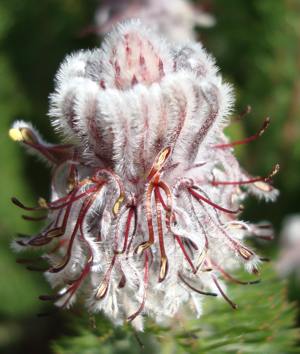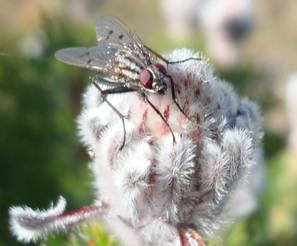Serruria brownii
Serruria brownii Meisn
Family: Proteaceae
Common names: Bottlebrush spiderhead ; fleskwasbos (Afr.)
Introduction
Serruria brownii is a charming and unusual shrublet. It can be tricky to cultivate but when growing happily will reward you with dense soft foliage and masses of purple-brown flowers.

Description
Description
Serruria brownii is an upright shrublet growing up to 0.3-0.5m tall and 0.3m wide.
Leaves are green and covered with soft grey hairs. They are short (15-25mm), dissected and curve upwards. The common name, bottlebrush spiderhead, comes from the arrangement of these leaves tightly crowded up the stem, resembling a bottlebrush.

Solitary flower heads bloom at the tip of each shoot and have a sweet scent. Each flower head measures 25×20mm and consists of 15-20 very small individual flowers. These flowers are an interesting mix of pink, purple, silver and brown. Flowering time is from June to October (winter to spring) and seeds are released 1-2 months after flowering.

Under optimum conditions the bottlebrush spiderhead grows fast and will quickly mature into a bushy shrublet. Fynbos species like serrurias are not long-lived plants and after 5-8 years start to have a rather scrappy appearance. It is best to replace them.
Conservation Status
Status
Only a small portion of the natural population of Serruria brownii occurs within protected nature reserves. This, coupled with a large drop in population size and disappearing subpopulations, has led to the species being Red Listed as Endangered.
Current threats to natural populations include invading alien acacias, expanding agriculture, such as wheat fields and vineyards, city sprawl, overgrazing livestock, and mining.
Distribution and habitat
Distribution description
Serruria brownii occurs in the transitional zone between fynbos and renosterveld. It grows in granitic or shale-derived deep soils, as well as heavy sands on low-lying flats at altitudes of 50-250m. It is restricted to the Western Cape where its natural distribution is from Hopefield on the West Coast all the way south to Cape Town.
Derivation of name and historical aspects
History
Serruria was named after Dr James Serrurier who was a professor of botany at Utrecht, Netherlands in the early 18th century.
The specific epithet, brownii, commemorates Robert Brown (1773-1858), an outstanding Scottish botanist. In 1810 his paper, On the Proteaceae of Jussieu, was published and was one of the earliest works detailing the systematics of Proteaceae. He is cited as author of many protea species with his author abbreviation being R.Br.
The Serruria genus contains about 55 species. They can be distinguished from other members of the protea family by their dissected leaves which have cylindrical segments. If the flower heads are solitary they are always on the tips of branches and if the flowerheads occur in multiples they are found in axils of the upper leaves. Spiderheads (Serruria spp.) occur only in the winter-rainfall fynbos regions.
Ecology
Ecology
Serruria brownii is specifically adapted for pollination by flies (order Diptera ). Flowers are not bold and brightly coloured as they do not need to attract pollinators like birds and butterflies. Flowers instead are scented and this is what attracts the flies.

Uses
Use
The bottlebrush spiderhead is not commonly cultivated or used culturally.
Growing Serruria brownii
Grow

The bottlebrush spiderhead requires the following in a fynbos garden: well-drained granitic soil that, once planted, is disturbed as little as possible, good air circulation and direct sunlight for most of the day. If drainage is a problem in your garden, try to build a slope and plant your fynbos along it. At Kirstenbosch, plants thrive along the higher slopes in the restio garden where soils have a granitic base. In the protea garden they do not grow as well, as the soil has a sandstone base.
Plants are prone to attack from fungi, specifically Phytopthora which causes root rot. This disease is exacerbated by applying too much water during warm weather.
Serruria brownii thrives in a winter-rainfall environment where summers are hot and dry. Plant young plants into your garden during late autumn or at the start of the rainy season. Additional water can be given during their first summer although if you have planted at the correct time, this is not necessary. Apply a thick layer of mulch to keep the soil cool and moist.
Serrurias do not require large amounts of feeding. Incorporate a small amount of well-rotted compost at planting and feed twice a year with a fertilizer specifically formulated for fynbos plants.
Serruria brownii can be propagated from cuttings or seed. Cuttings have a much higher success rate and are more freely available than seeds. Make cuttings from December to March (summer to autumn). The cuttings should be taken from the current season's growth and measure 30-70mm long. Dip the cuttings into a rooting hormone solution or hormone powder and plant into a medium of 50% polystyrene and 50% finely milled bark. Place in a growing house with bottom heat (25°C) and intermittent mist. Once the roots are well developed, remove from the mist unit and harden off for three weeks. Plant the cuttings into small pots using a fynbos potting mix and grow on until ready to plant into the garden.
References
- Rebelo, A. 2001. Proteas: A field guide to the proteas of Southern Africa , edn 2 . Fernwood Press & National Botanical Institute, Cape Town.
- Rebelo, A.G., Helme, N.A., Holmes, P.M., Forshaw, C.N., Richardson, S.H., Raimondo, D., Euston-Brown, D.I.W., Victor, J.E., Foden, W., Ebrahim, I., Bomhard, B., Oliver, E.G.H., Johns, A., Van der Venter, J., Van der Walt, R., Von Witt, C., Low, A.B., Paterson-Jones, C., Rourke, J.P., Hitchcock, A.N., Potter, L., Vlok, J.H. & Pillay, D. 2006. Serruria brownii Meisn. National Assessment: Red List of South African Plants version 2013.1. http://redlist.sanbi.org
- SIBIS: SANBI's Integrated Biodiversity Information System. http://sibis.sanbi.org/
- Vogts, M. 1982. South Africa's Proteaceae, know them and grow them . Struik, Cape Town.
- Wikipedia: The Free Encyclopedia. http://en.wikipedia.org
Credits
Louise Nurrish
Kirstenbosch National Botanical Garden
December 2013
Plant Attributes:
Plant Type: Shrub
SA Distribution: Western Cape
Soil type: Sandy, Clay, Loam
Flowering season: Winter
PH: Acid, Neutral
Flower colour: Brown, Purple
Aspect: Full Sun
Gardening skill: Challenging
Special Features:
Horticultural zones







Rate this article
Article well written and informative
Rate this plant
Is this an interesting plant?
Login to add your Comment
Back to topNot registered yet? Click here to register.